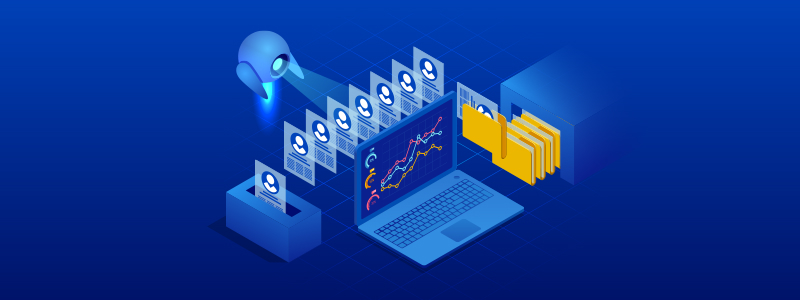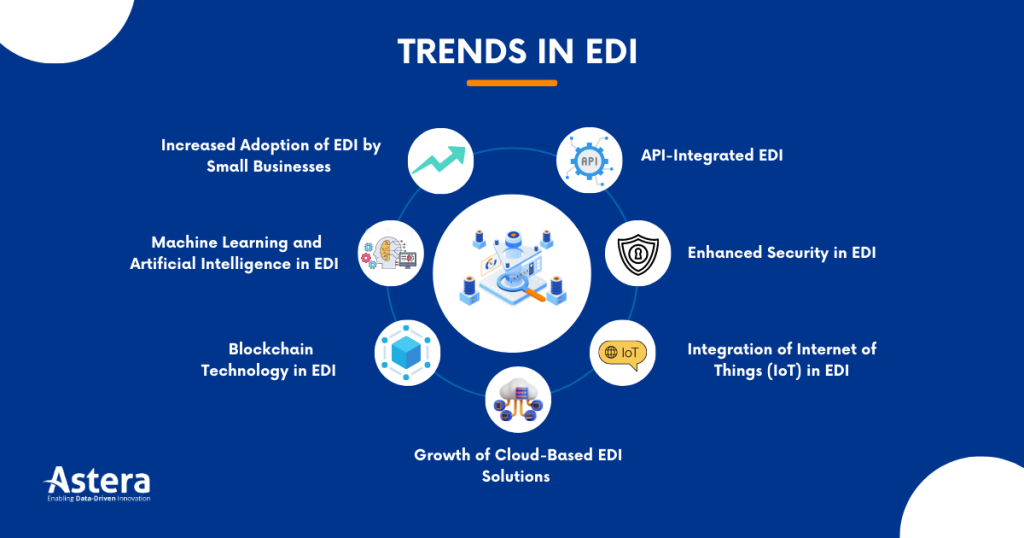
The Future of EDI: Innovations and Trends to Track
Electronic Data Interchange (EDI) has long been a cornerstone of modern business operations, enabling organizations to exchange business documents and data in a standardized electronic format.
In recent years, EDI’s evolution has been propelled by the advent of advanced technologies like artificial intelligence, cloud computing, and blockchain, as well as changing business requirements, including real-time data access, enhanced security, and improved operational efficiency.
This transformation is reflected in the anticipated growth of the global EDI software market, which is projected to soar from $1.98 billion in 2023 to $4.52 billion by 2030, marking a Compound Annual Growth Rate (CAGR) of 12.5%.
As we navigate 2023 and the years to come, we can anticipate several significant trends and innovations in EDI. Here’s a look at what the future of EDI might hold.

Increased Adoption of EDI by Small Businesses
The future of EDI is being primarily shaped by its growing prevalence among small businesses. Once considered a luxury only affordable to large corporations, EDI technology has become more accessible and affordable, making it an attractive proposition for smaller organizations. The competitive landscape of most industries necessitates that even small businesses engage in B2B transactions that require the efficient exchange of large volumes of data, which is a task perfectly suited to EDI.
For example, a small retailer may need to exchange invoices, purchase orders, and shipping notices with multiple suppliers. By adopting EDI, small businesses can automate these exchanges and reduce manual errors to expedite their processes, saving time and resources.
Moreover, given that small businesses strive to grow in scale, EDI systems are perfectly adaptable to such challenges, providing necessary scalability that allows businesses to handle increased data exchange volumes without compromising efficiency.
Machine Learning and Artificial Intelligence in EDI
The intersection of machine learning and artificial intelligence (AI) with EDI is another trend that could significantly impact the future of EDI. These technologies offer the potential to automate, optimize, and even revolutionize how businesses handle EDI.
Machine learning and AI can help automate data input and data mapping tasks in EDI processes. For instance, machine learning algorithms can be trained to understand different data formats and automatically map these to the appropriate EDI standard. This could eliminate the time-consuming and error-prone manual mapping process, enhancing the efficiency and accuracy of data exchanges.
Predictive analytics, a sub-field of AI, is also entering the EDI landscape. By analyzing past EDI transaction data, predictive models can forecast future trends and behaviors, helping businesses plan their operations more effectively. For example, by analyzing historical order data, businesses can predict future demand trends, allowing for better inventory management and planning.
Blockchain Technology in EDI
Blockchain, best known as the technology underpinning cryptocurrencies, has profound implications for the future of EDI due to its unparalleled security and reliability.
At its core, blockchain is a decentralized and immutable ledger, meaning it cannot be altered or deleted once data is added. Blockchain is particularly beneficial to EDI, as it can ensure the integrity and authenticity of the exchanged data.
For example, consider an EDI transaction in the supply chain industry. All transaction data could be stored on the blockchain, from purchase orders to shipping notices and invoices. Any dispute over a transaction could be easily resolved by referring to this immutable record, ensuring a single source of truth and minimizing the potential for disputes.
Furthermore, blockchain’s decentralized nature could open the door to peer-to-peer EDI transactions, removing the need for a central authority or VAN (Value-Added Network). This could lead to increased efficiency and reduced costs.
Integration of Internet of Things (IoT) in EDI
The Internet of Things (IoT) is another trend set to shape the future of EDI trends significantly. As more devices become “smart” and internet-enabled, businesses are finding new ways to harness this connectivity to improve their EDI processes.
IoT devices can collect vast real-time data, providing businesses with instant access to valuable information. When this capability is combined with EDI, it opens opportunities for more efficient and automated data exchanges.
For example, in a warehouse, IoT sensors could monitor inventory levels in real-time and automatically send reorder notifications via EDI when stocks fall below a certain level. This would streamline the inventory management process, reduce the likelihood of stockouts, and enable more efficient operations.
Similarly, GPS-enabled IoT devices could provide real-time tracking data for shipments in the logistics sector. This data could be automatically shared with relevant parties through EDI, providing timely updates and enhancing visibility in the supply chain.
Growth of Cloud-Based EDI Solutions
Cloud-based EDI solutions, owing to their scalability, accessibility, and cost-effectiveness, are becoming increasingly popular.
Cloud-based EDI solutions offer businesses the flexibility to scale their EDI operations as needed. For instance, a rapidly growing e-commerce business could easily increase its EDI capabilities to manage a sudden surge in order volume during peak shopping seasons.
Additionally, cloud-based EDI services ensure data accessibility from anywhere, a feature that has become especially important with the rise of remote work. Employees can access, monitor, and manage EDI transactions regardless of their location, enhancing operational continuity.
Cost-effectiveness is another key advantage. Traditional on-premises EDI infrastructure can be expensive to set up and maintain. In contrast, cloud-based EDI services often operate on a subscription model, reducing upfront costs and making EDI more accessible to small and midsize businesses.
For example, a small manufacturer might not have the financial or technical resources to set up a full-scale on-premises EDI system. By opting for a cloud-based EDI service, they can enjoy the benefits of EDI without a substantial upfront investment, enabling them to compete on a level playing field with larger competitors.
Enhanced Security in EDI
As businesses increasingly rely on electronic data interchange for critical business operations, ensuring the security of these transactions has become a top priority. Enhanced security features and protocols are, therefore a key trend shaping the future of EDI.
Cyber threats are evolving in sophistication. As a crucial part of businesses’ IT infrastructure, EDI systems are not immune to these risks. Protecting the integrity and confidentiality of EDI data is of paramount importance. As a result, EDI solutions are incorporating advanced security features such as encryption, two-factor authentication, intrusion detection systems, and more.
Additionally, with data protection regulations becoming more stringent globally, businesses are under more pressure to ensure their EDI transactions comply with these laws. EDI providers are, therefore, prioritizing features that assist with regulatory compliance.
For instance, in a healthcare setting where EDI is used for transmitting patient data, the system would need to comply with regulations such as HIPAA in the U.S. Enhanced security features in EDI systems, such as robust access controls and audit logs, can help healthcare providers ensure compliance while protecting sensitive patient information.
API-Integrated EDI
The increased use of Application Programming Interfaces (APIs) in EDI is a trend that could fundamentally alter the future of EDI. APIs allow for real-time, programmatic interaction between different software systems, providing a means to integrate EDI documents seamlessly into existing business applications.
API-integrated EDI can facilitate real-time data exchange, enhancing the speed and efficiency of business transactions. Rather than batch-processing EDI transactions at predetermined intervals, businesses can leverage APIs to process transactions immediately as they occur.
For example, an e-commerce platform could use APIs to integrate EDI directly into its order management system. When a customer places an order, an EDI message can be generated and sent to the relevant supplier in real-time, enabling faster order processing and delivery.
API-integrated EDI can also make it easier for businesses to incorporate EDI into their IT infrastructure. By using APIs, businesses can leverage EDI capabilities without replacing or heavily modifying their existing software systems.
However, this enhanced efficiency doesn’t come without its challenges. As APIs provide direct programmatic access to data, they could potentially increase the vulnerability of sensitive business information. Therefore, in the era of API-integrated EDI, businesses must prioritize robust security measures, including secure communication protocols, strong encryption, controlled API access, and routine security audits and monitoring.
Conclusion
As we have explored, the future of EDI is filled with promising trends and innovations that are reshaping how businesses handle electronic data interchange. From small companies increasingly leveraging the efficiency of EDI to major technological advancements such as AI, blockchain, and IoT, the landscape is evolving rapidly.
Cloud-based EDI solutions and enhanced security measures are becoming increasingly crucial, ensuring scalability, accessibility, and protection of crucial business data. Also, integrating APIs into EDI is streamlining data exchange and facilitating real-time transactions, paving the way for a new era of EDI.
Considering these emerging trends, choosing an EDI solution that’s future-ready is crucial. Astera EDIConnect is designed to simplify your EDI process, ensuring seamless integration and robust data security.
 Astera AI Agent Builder - First Look Coming Soon!
Astera AI Agent Builder - First Look Coming Soon!


